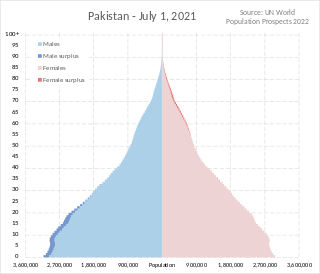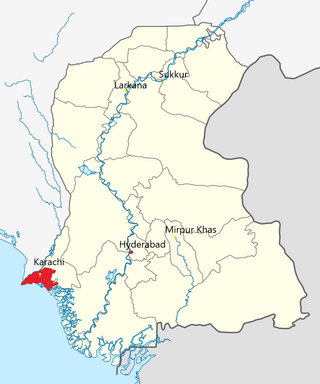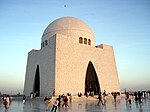
Karachi is the capital city of the Pakistani province of Sindh. It is the largest city in Pakistan and the 12th largest in the world, with a population of over 20 million. It is situated at the southern tip of the country along the Arabian Sea coast and formerly served as the capital of Pakistan. Ranked as a beta-global city, it is Pakistan's premier industrial and financial centre, with an estimated GDP of over $200 billion (PPP) as of 2021. Karachi is considered Pakistan's most cosmopolitan city, and among the country’s most linguistically, ethnically-, and religiously-diverse regions, as well as one of the country’s most progressive and socially liberal cities.

Pakistan had a population of 241,492,197 or 241.49 Million according to the final results of the 2023 Census. This figure includes Pakistan's four provinces e.g. Punjab, Sindh, KPK, Balochistan and Islamabad Capital Territory. AJK and Gilgit-Baltistan's census data is yet to be approved by CCI Council of Pakistan. Pakistan is the world's fifth most populous country.

Hyderabad is a city and the capital of Hyderabad Division in the Sindh province of Pakistan. It is the second-largest city in Sindh, and the fifth largest in Pakistan.

Orangi is a municipality approximately 57 square kilometres (22 sq mi) in an area that forms much of the northwestern part of Karachi in Sindh, Pakistan. When grouped with the neighboring municipality of Baldia Town, the Orangi-Baldia population is estimated to be over 2.4 million. Orangi is the world's largest and most populated slum, with a population of 2.4 million, twice that of Mexico's Ciudad Neza, Mexico City and more than twice that of India's Dharavi, Mumbai.

The Federal Capital Territory (FCT) around Karachi was the original capital territory of Pakistan. The FCT was created in 1948 from the city of Karachi and surrounding areas as the location for Pakistan's capital following its creation. The FCT was bordered by the province of Sindh to the northeast and the princely state of Las Bela to the northwest with the Arabian Sea to the south.

The area of Karachi in Sindh, Pakistan has a natural harbor and has been used as fishing port by local fisherman belonging to Sindhi tribes since prehistory. Archaeological excavations have uncovered a period going back to Indus valley civilisation which shows the importance of the port since the Bronze Age. The port city of Banbhore was established before the Christian era which served as an important trade hub in the region, the port was recorded by various names by the Greeks such as Krokola, Morontobara port, and Barbarikon, a sea port of the Indo-Greek Bactrian kingdom and Ramya according to some Greek texts. The Arabs knew it as the port of Debal, from where Muhammad bin Qasim led his conquering force into Sindh in AD 712. Lahari Bandar or Lari Bandar succeeded Debal as a major port of the Indus; it was located close to Banbhore, in modern Karachi. The first modern port city near Manora Island was established during British colonial Raj in the late 19th century.
The ethnic groups in Karachi includes all the ethnic groups in Pakistan. Karachi's inhabitants, locally known as Karachiwala, are composed of ethno-linguistic groups from all parts of Pakistan, as well as migrants from South Asia, making the city's population a diverse melting pot. At the end of the 19th century, the population of the city was about 105,000, with a gradual increase over the next few decades, reaching more than 400,000 on the eve of independence. Estimates of the population range from 15 to 18 million, of which an estimated 30% are migrants from different backgrounds. The city's population is estimated to be growing at about 5% per year, including an estimated 45,000 migrant workers coming to the city every month from different parts of Pakistan.
The cultural history of Karachi goes back at least five thousand years to the emergence of the Indus Valley Civilization in the third millennium BC. The early culture is mostly Neolithic with widespread usage of small cart implements and semi-precious stones. The many megalithic Arab graves around Karachi gave evidence towards megalithic movements of the Arabian Peninsula.

Pakistan is one of the world's most ethnically and linguistically diverse countries. The major Pakistani ethnolinguistic groups include Punjabis, Pashtuns, Sindhis, Gujjar, Saraikis, Muhajirs, Balochs, Paharis and Brahuis, with significant numbers of Baltis, Kashmiris, Chitralis, Shina, Kohistanis, Torwalis, Hazaras, Burusho, Wakhis, Kalash, Siddis, Uzbeks, Nuristanis, Pamiris, Hindkowans, Kyrgyz, Turkmen, Uyghurs and other various minorities.

The Muhajir people are Muslim immigrants of various ethnic groups and regional origins, and their descendants, who migrated from various regions of India after the Partition of India to settle in the newly independent state of Pakistan. The community includes those immigrants' descendants, most of whom are settled in Karachi and other parts of urban Sindh. The Muhajir community also includes stranded Pakistanis in Bangladesh who migrated to Pakistan after 1971 following the secession of East Pakistan in the Bangladesh Liberation War.
Sindhi Pathan is the name of Pashtun communities living in Sindh for centuries that have adopted the norms and culture of Sindh.

Targeted killings in Pakistan have been a rising form of violence and have contributed to security instability in the country. They have become common and have gained attention especially in Karachi, Pakistan's largest city, economic capital and capital city of the Sindh province. Several targeted killings have also occurred in Quetta, the capital of the southern province of Balochistan. Police and law enforcement agencies have sometimes come under criticism for their ineffectiveness in locating the perpetrators and investigating their motives. For most part, targeted killings in Karachi have been attributed to political, religious and ethnic reasons. There are speculations about the killing but no real proof has been found against any party.
The Qasba–Aligarh massacre was an ethnic massacre that took place when recently settled armed tribal Pashtuns from KPK, Pakistan and Afghanistan attacked densely populated civilized locals in Qasba Colony, Aligarh Colony and Sector 1-D of Orangi in Karachi in the early hours of the morning on 14 December 1986. According to official reports, around 49 people were killed and several hundred were injured in what was perceived as a "revenge killing" by newly settled armed Pashtuns following an unsuccessful raid on a Pashtun heroin processing and distribution center in Sohrab Goth by the security forces. Most of the residents of the two colonies happened to be Muhajirs like Biharis who had been freshly repatriated from Bangladesh.

Operation Lyari was a Pakistan Government crackdown against local gangs and other crime syndicates and part of the greater Karachi Operation.
Usmania Colony or Osmania Colony is a neighbourhood of Liaquatabad Town in Karachi, Sindh, Pakistan.

The demographic history of Karachi of Sindh, Pakistan. The city of Karachi grew from a small fishing village to a megacity in the last 175 years.
Muhajir culture is the culture of the various Muslims of different ethnicities who migrated mainly from North India in 1947 generally to Karachi, the federal capital of Pakistan and before 1947 Karachi is the capital of Sindh. They consist of various ethnicities and linguistic groups. The Muhajirs are mainly concentrated in Karachi and Hyderabad.
The Sindh Mohajir Punjabi Pathan Muttahida Mahaz was a political party in the Pakistani province Sindh. The party was founded in 1969. Nawab Muzaffar Khan was the convenor of MPPM. In theory the party sought to serve as a political platform for Muhajirs, Pashtuns and Punjabis in Sindh, but in reality it functioned as a Muhajir political party as the Pashtun and Punjabi presence in the MPPM ranks was very limited. The party mobilized Urdu-speaking Muhajirs against the emerging Sindhi nationalist movement. It was led by Muhajir bureaucrats and businessmen. The main base of the MPPM was the city of Hyderabad.

The Muhajir Province or Karachi Province or South Sindh is a proposed province movement in the Pakistani province of Sindh. This movement is backed by a Muhajir pan-nationalist political and ethnic movement seeking to establish a separate province in Sindh which seeks to represent the Muhajir people of Pakistan. It is proposed to consist of Muhajir-majority areas of Sindh which would be independent from Sindh government.

Muhajir History or History of Muhajirs refers to the history and origins of the Muhajir people in Pakistan. Most Muhajirs migrated from what is now Uttar Pradesh, Rajasthan, Bihar, Gujarat, and West Bengal and that results in close ties between the ethnic groups and histories.














